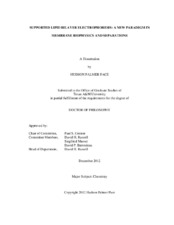| dc.contributor.advisor | Cremer, Paul S | |
| dc.creator | Pace, Hudson 1982- | |
| dc.date.accessioned | 2013-03-14T16:17:45Z | |
| dc.date.available | 2014-12-12T07:18:55Z | |
| dc.date.created | 2012-12 | |
| dc.date.issued | 2012-11-28 | |
| dc.date.submitted | December 2012 | |
| dc.identifier.uri | https://hdl.handle.net/1969.1/148239 | |
| dc.description.abstract | The motivation of this work was to produce novel analytical techniques capable of probing the physical properties of the cell surface. Many researchers have used supported lipid bilayers (SLBs) as models to study the structure and function of the cell membrane. The complexity of these models is consistently increasing in order to better understand the myriad of physiologically relevant processes regulated by this surface. In order to aid researchers in studying such phenomenon, the following contributions were made.
To manipulate components within the cell membrane, an electrophoretic flow cell was designed which can be used as a probe to study the effect of electrical fields on charged membrane components and for the separation of these components. This devise allows for the strict control of pH and ionic strength as species are observed in real-time using fluorescence microscopy. Additionally, advancements have been made to the production of patterned heterogeneous SLBs for use in separations and to probe the interactions of membrane components. The methodology to couple SLB separations and matrix-assisted laser desorption ionization mass spectrometry (MALDI-MS) imaging was devised. This technology allows for the label-free mapping of the SLB surface post electrophoresis in order to observe naturally occurring species unperturbed by the addition of extrinsic tags. The final contribution, and perhaps the greatest, is the development of a procedure to create highly mobile SLBs from native membranes. These surfaces have vast potential in that they are no longer simple models of the cell surface, they are in fact the actual cell surface made planar. This advancement will be of great use to biophysicists and biochemists interested in using surface specific analytical methods to better understand physiological processes. These highly mobile native membrane surfaces have been coupled with the SLB electrophoresis technology to separate discrete bands of lipids and proteins, a proof of principle that will hopefully be further developed into a standard method for membrane proteomic studies.
Collectively the tools and methodologies described herein show great potential in allowing researchers to further add to mankind’s understanding of the cellular membrane. | en |
| dc.format.mimetype | application/pdf | |
| dc.subject | Biophysics | en |
| dc.subject | MALDI-MS Imaging | en |
| dc.subject | Separations | en |
| dc.subject | Membrane Proteins | en |
| dc.subject | Electrophoresis | en |
| dc.subject | Supported Lipid Bilayers | en |
| dc.title | Supported Lipid Bilayer Electrophoresis: A New Paradigm in Membrane Biophysics and Separations | en |
| dc.type | Thesis | en |
| thesis.degree.department | Chemistry | en |
| thesis.degree.discipline | Chemistry | en |
| thesis.degree.grantor | Texas A&M University | en |
| thesis.degree.name | Doctor of Philosophy | en |
| thesis.degree.level | Doctoral | en |
| dc.contributor.committeeMember | Russell, David H | |
| dc.contributor.committeeMember | Musser, Siegfried | |
| dc.contributor.committeeMember | Barondeau, David P | |
| dc.type.material | text | en |
| dc.date.updated | 2013-03-14T16:17:45Z | |
| local.embargo.terms | 2014-12-01 | |


